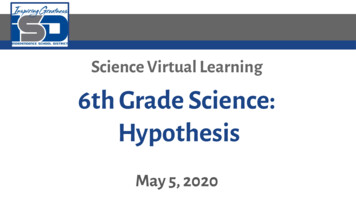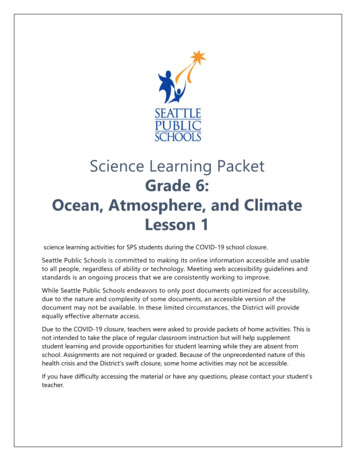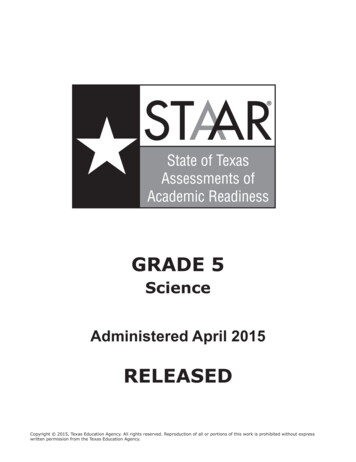
Transcription
SCIENCE:GRADE 2–FORCE AND MOTION
Force and MotionMagnets in Everyday LifeTEKSGRADE 22 (6) Force, motion, and energy. The student knows that forces causechange and energy exists in many forms.(B) The student is expected to observe and identify how magnets are usedin everyday life.Content ObjectiveI can identify how magnets are used in everyday life.ScienceScience Process Skills2 (1) Scientific investigation and reasoning. The student conductsclassroom and outdoor investigations following home and schoolsafety procedures.(A) The student is expected to identify and demonstrate safe practices asdescribed in the Texas Safety Standards during classroom and outdoorinvestigations, including wearing safety goggles, washing hands, and usingmaterials appropriately.2 (2) Scientific investigation and reasoning. The student developsabilities necessary to do scientific inquiry in classroom and outdoorinvestigations.(A) The student is expected to ask questions about organisms, objects, andevents during observations and investigations.(B) The student is expected to plan and conduct descriptive investigationssuch as how organisms grow.(D) The student is expected to record and organize data using pictures,numbers, and words.2 (3) Scientific investigation and reasoning. The student knows thatinformation and critical thinking, scientific problem solving, and thecontributions of scientists are used in making decisions.(A) The student is expected to identify and explain a problem in his/her own314
Force and Motionwords and propose a task and solution for the problem such as a lack ofwater in a habitat.GRADE 22 (4) Scientific investigation and reasoning. The student usesage-appropriate tools and models to investigate the natural world.(A) The student is expected to collect, record, and compare informationusing tools, including computers, hand lenses, rulers, primary balances,plastic beakers, magnets, collecting nets, notebooks, and safety goggles;timing devices, including clocks and stopwatches; weather instrumentssuch as thermometers, wind vanes, and rain gauges; and materials tosupport observations of habitats of organisms such as terrariums andaquariums.2 (5) Matter and energy. The student knows that matter has physicalproperties and those properties determine how it is described,classified, changed, and used.(D) The student is expected to combine materials that when put togethercan do things that they cannot do by themselves such as building a toweror a bridge and justify the selection of those materials based on theirphysical properties.Mathematics2 (13) Underlying processes and mathematical tools. The studentcommunicates about Grade 2 mathematics using informal language.(A) The student is expected to explain and record observations usingobjects, words, pictures, numbers, and technology.2 (14) Underlying processes and mathematical tools. The student useslogical reasoning. The student is expected to justify his or herthinking using objects, words, pictures, numbers, and technology.English Language Arts and Reading2 (28) Listening and speaking/listening. Students use comprehension skillsto listen attentively to others in formal and informal settings. Studentscontinue to apply earlier standards with greater complexity.(A) Students are expected to listen attentively to speakers and ask relevantquestions to clarify information. 2012 TEXAS EDUCATION AGENCY. ALL RIGHTS RESERVED.315
Force and MotionGRADE 22 (29) Listening and speaking/speaking. Students speak clearly and to thepoint, using the conventions of language. Students continue to applyearlier standards with greater complexity. Students are expected toshare information and ideas that focus on the topic under discussion,speaking clearly at an appropriate pace, using the conventions oflanguage.2 (30) Listening and speaking/teamwork. Students work productively withothers in teams. Students continue to apply earlier standards withgreater complexity. Students are expected to follow agreed-uponrules for discussion, including listening to others, speaking whenrecognized, and making appropriate contributions.Figure 19.Reading/comprehension skills. Students use a flexible range ofmetacognitive reading skills in both assigned and independentreading to understand an author’s message. Students will continueto apply earlier standards with greater depth in increasingly morecomplex texts as they become self-directed, critical readers.(C) The student is expected to monitor and adjust comprehension (e.g.,using background knowledge, creating sensory images, re-reading aportion aloud, generating questions).(D) The student is expected to make inferences about text using textualevidence to support understanding.(F) The student is expected to make connections to own experiences,to ideas in other texts, and to the larger community and discuss textualevidence.316
Force and MotionEnglish Language Proficiency StandardsGRADE 22 (I) Cross-curricular second language acquisition/listening. The student isexpected to demonstrate listening comprehension of increasingly complexspoken English by following directions, retelling or summarizing spokenmessages, responding to questions and requests, collaborating with peers,and taking notes commensurate with content and grade-level needs.3 (D) Cross-curricular second language acquisition/speaking. The student isexpected to speak using grade-level content area vocabulary in context tointernalize new English words and build academic language proficiency.Language ObjectiveI can follow spoken and written instructions to complete a task.Response to Intervention/Tier 1 DifferentiationAll science lessons support students in receiving quality Tier 1 instruction. Using the 5Emodel, knowledge is taught in a variety of contexts, integrating math, science, and ELAcontent, thus supporting the active engagement of students with the content.Lesson-specific differentiation strategies for addressing diverse student needs can befound throughout each lesson in sections titled “Differentiation Strategy.”Differentiation should focus on skills students did not understand and extend the lesson for advancedstudents; be conducted in small groups or embedded in whole-group instruction; and provide students with a variety of strategies to process the information, such as-- allowing for additional opportunities for verbal brainstorming of wordsassociated with a topic (with teacher taking dictation);-- making clear connections of new and more complex concepts to foundationalaspects and prior knowledge;-- participating in more tangible experiences, such as experiments,investigations, and active exploration;-- sorting academic vocabulary words into categories by common attributes—process words or science content vocabulary; 2012 TEXAS EDUCATION AGENCY. ALL RIGHTS RESERVED.317
Force and Motion-- organizing brainstorming into semantic maps or creating graphic organizers;-- discussing the meaning of a graphic organizer with a partner; andGRADE 2-- creating a visual representation to demonstrate understanding.See the handout in the Content Resources section that addresses instructional strategies.College and Career Readiness StandardsI.C1 Collaborative and safe working practices. Collaborate on joint projects.I.E1 Effective communication of scientific information. Use several modes ofexpression to describe or characterize natural patterns and phenomena. Thesemodes of expression include narrative, numerical, graphical, pictorial, symbolic,and kinesthetic.Vocabulary Focusmagnetsidentifyobserve318
Force and MotionPrerequisite Science KnowledgeGRADE 2K (6)(B) The student is expected to explore interactions between magnets andvarious materials.1 (6)(B) The student is expected to predict and describe how a magnet can beused to push and pull an object.5E Lesson SummaryEngageStudents identify everyday uses of magnets.ExploreStudents explore how magnets are used in everyday objects.ExplainStudents explain and explore everyday uses of magnets.ElaborateStudents identify a problem that could be solved with a magnet and create a solution.EvaluateStudents illustrate how they use magnets every day. 2012 TEXAS EDUCATION AGENCY. ALL RIGHTS RESERVED.319
Force and MotionEngageGRADE 2Advance PreparationMaterialsFor teacher RM 1,printed incolor orprojected objects withmagnetsGather objects with magnets, such as a purse or a phone case with amagnetic closure, jewelry with a magnetic clasp, refrigerator magnets, ascrewdriver with a magnetic tip, and a paper clip holder.Differentiation StrategyELL: Display the photos from RM 1: Everyday Magnet Photos and askstudents to use magazines or the Internet to gather additional picturesof everyday objects that use magnets. Students will then create aninteractive photo board of magnetic items. Identify each object or photowith a label.Teacher InstructionVisit stitute thisGlog for RM 1.320 Display the pictures from RM 1 and the gathered objects for allstudents to observe. Ask the following: What do all these items have in common? Acceptall reasonable answers. Ask the following: Which of these objects have magnets and whichdo not? Answers will vary based on objects used. Lead students to discover that each object uses magnets in oneway or another. At this time, students need to understand only thatmagnets are used in many ways. Ask the following: Did you know that magnets were used in so manyways? Which of these magnet examples surprised you? Accept allreasonable answers.
Force and MotionExploreWorld’s Simplest Motors can be purchased from educational supplycompanies or some craft stores. Use the instructions below to partiallyprepare a World’s Simplest Motor for each student group. Then placethe motor pieces into a resealable plastic bag for each student group.Straighten the wire.1. Measure 5 cm from one end of the wire and make a small bend.2. Put on your safety goggles to protect your eyes from loose wires.3. Wrap the rest of the wire after the bend around the battery.4. Leave about 5 cm of wire sticking straight out to match the other endof wire (Figure 1).Figure 1GRADE 2Advance PreparationMaterialsFor teacher RM 2 D-cell battery resealableplastic bags World’sSimplestMotor safetygoggles metric rulerFor studentgroups RM 2 5 centimetercubes D-cell battery World’sSimplestMotor 5. Slide the wire off the battery (Figure 2).Figure 2 2012 TEXAS EDUCATION AGENCY. ALL RIGHTS RESERVED.321
Force and MotionGRADE 26. Wrap each end of wire tightly around the coil three times to keepthe coil together. Make sure the ends stick out at least 3 cm directlyopposite each other (Figure 3).Figure 37. Place one end of the wire on the table (Figure 4).Figure 48. Use the edge of the metal support to scrape the coating off thetop half of the wire from the end of the wire to the coil. Repeat thisprocess for the wire on the other side of the coil (Figure 5).Figure 59. Prepare a setup for each group and place it in a resealable plasticbag.10. Test each setup to make sure it works before using the setups withstudents. If the coil catches on the plastic holder, flatten the coil a littleto help it spin freely.322
Force and MotionTeacher NoteRemove the coils from the metal supports to avoid depleting the batteries.GRADE 2Content BuilderHow the motor works: The battery sends an electric current through thewires when they touch the metal supports. There is a magnetic fieldaround any wire carrying a current. The coil of wire is magnetized by thecurrent flowing through it. The coil of wire is attracted to and then repelledby the magnet of the motor, causing the coil of wire to spin. The morecurrent that is run through the wire, the faster the motor turns.Teacher Instruction Pass a prepared set of materials to each group of four students. Instruct students to follow the directions on RM 2: Make a SimpleMotor to complete a simple motor. Model and describe each step on RM 2 for the class or groups asneeded.Facilitation Questions What do you observe when you place the wires into the metalsupports and hold the coil in place with the shiny sides down? Thecoil pushes away from the magnet. What happens if you flip the magnet over? The speed at which thecoil spins changes. The coil will spin faster or slower depending onthe side of the magnet facing up. Does the motor work if you remove the magnet? No, the coil doesnot spin on its own if the magnet is not in place. Does the motor work if you remove the battery? No, the coil doesnot spin if the battery is not in place. Do all the parts in the system need to be in place for the motor towork? Yes, all the parts must be in place for the system to work. 2012 TEXAS EDUCATION AGENCY. ALL RIGHTS RESERVED.323
Force and MotionExplainGRADE 2MaterialsFor teacher D-cell battery mini flatheadscrewdriver small hobbymotor paper clip short sectionsof wire withend stripped PopularMagnetics:Magnets inEveryday Usebook small hobbymotor headphones large paperclip resealableplastic bagsFor eachstudent sciencenotebookFor studentgroups small hobbymotor paper clip324Teacher NoteSmall hobby motors can be purchased from electronics or crafts stores.Purchase motors without gears. If the motor does not come with wiresattached, you will need to strip short sections of wire for the teacherdemonstration. Strip the insulation from the wires by gently and partiallyclosing scissors on the wire and twisting the scissors around theinsulation, being careful to not cut through the wire. Once the insulationhas been cut, slide it off the wire.A screwdriver used for eyeglasses repair will work as a mini flatheadscrewdriver.Inexpensive headphones are recommended for this lesson.Advance PreparationSmall Hobby MotorUse a mini flathead screwdriver to loosen, or open, the clips on the plasticend of the small hobby motors. This will allow students to easily removethe end covering of the motor. There is a coil of wire and a magnet insidethe motor. The coil of wire is attached to the shaft. Pull the shaft of themotor out to investigate the magnet inside.Place the student materials in a resealable plastic bag for each group.coil of wireshaftmagnet
Force and MotionEarphoneGRADE 2Remove the covering of the earphone and open it. Remove the plasticcovering of the speaker inside. Use a paper clip to detect the magnetinside the earphone.Be careful not to damage the diaphragm, which usually is made of thinplastic.earphonemagnetSafety Alerts Remind students not to use magnets around electrical outlets andother objects such as speakers and computers. Do not allow students to disassemble motors, headphones, or otherobjects without adult supervision.Teacher Demonstration Hold a wire from the motor on each end of the battery and allow allstudents to observe the motor working. Ask the following: Did you know that a magnet helps make thismotor work? Place a paper clip on the motor and show that it is attracted to themotor. Display a motor with the plastic end removed. Use a paper clip to identify the magnet inside the motor.Teacher Instruction Pass a set of materials to each group of four students. 2012 TEXAS EDUCATION AGENCY. ALL RIGHTS RESERVED.325
GRADE 2Force and Motion Instruct students to remove the plastic end of the motor and to usethe paper clip to identify the magnet. Allow adequate time for each student to observe the motor.Facilitation Questions How is this small motor like the motor you built during Explore? Bothmotors have a coil of wire that interacts with a magnet to make itwork. Both motors require electricity to work. What other objects can you name that may have magnets in them?Use motors to work? Answers may include everyday objects likepurses with magnetic closures and objects with motors like clothesdryers, televisions, and computers.Teacher InstructionUseProject ShareePortfolioBlog tool togather studentresponses. Referto the “ePortfolioBlog” video inyour ScienceAcademies forGrades K–4Project Sharegroup. Read and discuss Popular Magnetics: Magnets in Everyday Use. Pause as you read about the headphones, and use the paper clip toshow that it is attracted to an earphone. Pass the earphone around with the paper clip so students canobserve the magnet in the earphone.Facilitation Questions Did you know that magnets were part of so many things? What usesof magnets surprised you? Answers will vary. How are magnets used in everyday life? Answers will vary and mayinclude that magnets are used to hold papers to refrigerators, keeppurses closed, and pick things up. Magnets are also found in manythings, such as headphones, and in things with motors, such asceiling fans and electric toothbrushes.Science Notebook Entry What would your life be like without magnets? Can you think of a problemyou could solve using a magnet or a way that magnets could help simplifya part of your daily life?326
Force and MotionElaborateStudents will be asked to identify a problem that could be solved by usinga magnet and to create a solution to the problem. They will not be requiredto build or test their solutions but may be given materials to help withthe planning and the experimenting process. Students should include adescription of the role the magnet plays in the solution by answering thefollowing question: Is it a pushing force or a pulling force?Teacher Instruction Display the pictures of RM 1 for all students. Ask students to identify the use of magnets in the pictures. Divide the class into groups of four students. Instruct student groups to identify a problem that could be solved byusing a magnet. Students may use their science notebook entriesfrom Explain as inspiration. Instruct students that the solution or invention should use at leastone magnet. Instruct students to describe, illustrate, and label the drawings oftheir scenarios in their science notebooks.GRADE 2Teacher NoteMaterialsFor teacher RM 1 fromEngageFor eachstudent sciencenotebook pencilVisit http://edu.glogster.com to useGlogster EDUfor studentpresentations.Facilitation Questions What problem could you solve with a magnet? Answers will vary. Why do you think a magnet could help accomplish this task?Answers will vary. 2012 TEXAS EDUCATION AGENCY. ALL RIGHTS RESERVED.327
Force and MotionEvaluateGRADE 2Teacher InstructionMaterials For eachstudent sciencenotebookInstruct students to list and illustrate three ways they use magnetsevery day or three ways magnets are used in everyday life. Students should demonstrate an understanding of how magnetsinteract with other magnets and other materials and how magnetsare and can be used in everyday life.Visithttp://www.voicethread.com to useVoiceThreadfor students todemonstratetheirunderstandingof how magnetsare used ineveryday life.328
Grade 2RM 1: Everyday Magnet Photosrefrigerator magnetcan openercompasscredit cardelectric toothbrushelectromagnet 2012 TEXAS EDUCATION AGENCY. ALL RIGHTS RESERVED.331
Grade 2RM 1: Everyday Magnet Photos continuedpaper clip holderceiling fantoastergeneratormaglev traindoorbell 2012 TEXAS EDUCATION AGENCY. ALL RIGHTS RESERVED.333
Grade 2RM 2: Make a Simple MotorMaterials D-cell battery World’s Simplest Motor Steps1. Push the U end of the metal support through the slot on the end of the base. Thebumps in the supports need to face each other (Figure 1).2. Repeat this step with the other metal support.3. Push the battery into the base, making sure the battery touches the supports.4. Place the magnet in the round holder on top of the base (Figure 1).Set the straight ends of the wire on the supports (Figure 2).Figure 1Figure 25. Push the coil to make it spin. If it does not continue to spin on its own, try turning thecoil the other direction.Not working? Are the shiny sides of the wires both facing up (Figure 1)? Is the coil centered (Figure 2)?Try this: Will the motor work if you remove the magnet? What happens if you flip the magnet over? Does the motor work if you hold the magnet above the coil? 2012 TEXAS EDUCATION AGENCY. ALL RIGHTS RESERVED.335
NOTES
NOTES
All science lessons support students in receiving quality Tier 1 instruction. Using the 5E model, knowledge is taught in a variety of contexts, integrating math, science, and ELA content, thus supporting the active engagement of students with the content. Lesson-specific differentiati











